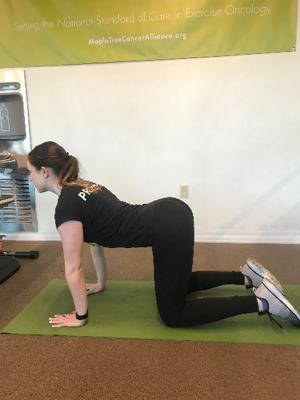Yoga is a very popular activity that can help in the maintenance of health and wellness, boost energy levels, and increase immune function. There is a growing body of evidence to support that yoga is beneficial to breast cancer survivors. These benefits include:
- Gains in strength
- Improvements in physical well being
- Positive effects on affected arm symptoms
- Decreases in distress, anxiety, and fatigue
- Increased quality of life
Special Considerations
Breast cancer survivors may experience pain, weakness, and decreased range of motion of the affected arm as a result of their cancer treatments. They may also develop lymphedema (an accumulation of lymph fluid in the arm).
Current guidelines suggest that participants wear compression arm sleeves and avoid any postures that result in arm pain.
Range of Motion Postures
When beginning a yoga program for the first time, it is advised that participants initially focus on increasing range of motion for the upper body. Cat/Cow is a great way to do this!
- Cat/Cow:
Inhale to draw the belly button up, rounding the spine and tucking the chin and tailbone. Exhale to release tension in the stomach, looking forward and dropping the belly low.
Tip: If you can’t get on the floor, perform the same motions in a chair.



If at any moment you feel sharp or shooting pains, stop the motion immediately and take a few moments to check in with yourself. You are the best judge of what is normal and abnormal when it comes to your body. Proceed slowly and know that you can always contact your doctor or a movement specialist with questions.
The following poses are also great ways to improve your upper body range of motion:
- Downward facing dog (wall):
Place both hands on a wall and raise them as high as you can. Take one or two steps away from the wall. Sink your hips back and allow your upper body and head to release towards the floor. Move slowly, stopping or adjusting as necessary.
Tip: Progress this pose by moving to a lower surface like a counter or chair!

- Puppy pose (wall):
Place hands and forearms on a wall and take one step away. In a similar fashion as above, allow hips to sink back and the upper body to release towards the floor. Keep the forearms connected to the wall at all times, and bend your knees if necessary.

- Child’s Pose + variations:
Begin in all fours on the floor. Separate your knees, and bring your big toes close together behind you. Sink your hips back towards your heels and walk your hands out above your head as far as you can.
Tip: If your forehead is unable to meet the floor, place a block or pillow there for it to rest on. If you have trouble sitting back towards your heels, try placing a pillow between your hamstrings and your calves. Each of these stretches can also be performed on a wall!

- Tented fingertips
Dome your hands by lifting the palms and keeping the fingertips connected to the floor.

- Side reaches
Reach both hands up and to the left as far as you can. You should feel a stretch and slight distraction in your right shoulder. Breathe deep and relax. Repeat on the other side.

- Thread the needle
Reach one arm up underneath you, “threading the needle” through your opposite arm. Feel your shoulder blade opening away from your spine, and reach further as necessary.

- Chest Opener
Place one arm out to your side like a “T” with your palm facing the floor. Inhale, and open the chest away from your extended arm.
Tip: If it is too intense to extend your arm all the way out to your side, bend your elbow to ninety degrees and perform the same stretch in that position.

Strengthening Exercises
For strengthening exercises, modifications may be needed for postures that place a lot of body weight on the arms. The Press/Pull pose is a great posture to start building strength with, and then progress to a Push/Pull pose. Finally, the Bird Dog pose is a great pose to build range of motion, strength, balance, and confidence:
- Press/Pull:
Inhale to press, exhale to pull
Tip: If it’s too much pressure to push your hands together, instead imagine holding a ball between them. Press into that imaginary ball instead of your actual hands.


- Push/Pull:
Inhale to open the chest and squeeze the shoulder blades together. Exhale to round your back and draw the belly button towards your spine as your arms extend in front of you.


- Bird Dog:
Begin in all fours. First try to lift one of your legs until it is parallel with the ground. Concentrate on keeping the shoulders and hips squared to the floor. Once stable, practice lifting the opposite arm in the same fashion. Alternate sides, focusing on stability and core strength.
Tip: If this is too difficult on the floor, or puts too much pressure on your arms, try it using the back of a chair, a countertop, or a wall.



Don’t forget to breathe!
